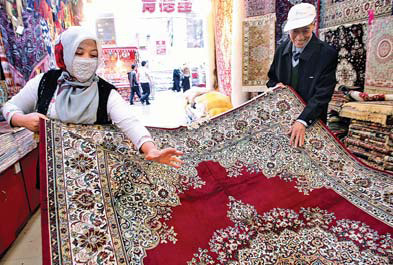Xinjiang is something of a myth to the Japanese, many of whom, including myself, first learn of it as part of the Western Regions through the Chinese classic Journey to the West. The 16th century novel is the subject of a legion of cartoons, books and animated films that still fascinate young Japanese today.
In the early 1980s the TV documentary The Silk Road was broadcast in Japan. It became an instant hit and gave rise to a spate of programs and books on the ancient route, renewing Western Regions fever. Tales of the exotic Western Regions have piqued the imagination of Japanese people for generations. As early as 1,300 years ago, precious handicrafts from this area were brought into Japan.Some of them are now exhibited in the museums of Nara, drawing hundreds of thousands of visitors every year.
Many Japanese aspire to visit Xin-jiang by way of the Silk Road. It is no easy task. Xinjiang is big – four times the territory of Japan – and far away, and tourist spots are scattered all around the region. The trip takes a long time and a good sum of money. For these reasons, many Japanese decide to make the trip after they retire.
I met a tour group from Japan at the East Gate Bazaar (International Trade Market of Central and Western Asia) in Kashgar in southwestern Xinjiang. Most members of the group were retirees who had been to the region before. Asked why they had made the second visit, one replied, “I was enchanted by the landscape, culture and customs during my first trip, and our local tour guides were attentive and hospitable. So here I am again.”
Some Japanese balked at their Xinjiang plan over security concerns, and some ditched the idea after opposition from family members. Although there is a glut of information about ancient Xinjiang in Japan, knowledge about its present is lacking. The Japanese visitors I met during my stay in Xinjiang all said that they felt safe in the area and didn’t notice any tension among locals, a reassurance for my fellow countrymen at home.
 |
|
A store owner shows carpets to a potential customer at International Grand Bazaar in Urumqi, capital of Xinjiang Uygur autonomous region.
|
Modern Xinjiang
Xinjiang has undergone tremendous changes in the 30-plus years since The Silk Road was first aired in Japan; changes that are, however, little known to my people. For instance, few have any idea that the hops used by Japanese beer producers are imported from Xinjiang, as is the ketchup on omuraisu, or rice omelette. I am one of the informed few, but was still amazed at what I saw when I first set foot in Urumqi, the regional capital – so different from what I saw in the documentary. I anticipated a drab town amid a boundless desert; but what unfurled before me was a modern metropolis where international-brand fastfood and grocery chain stores were a common sight and the fashion sense of people in the street was as sharp as those in Beijing.
I saw the “Loulan Beauty” (a mummy from the ancient Loulan Kingdom unearthed at Lop Nor in southeastern Xinjiang in 1980) in the Xinjiang Museum, which was exhibited in Japan in 1992, and created a sensation. The museum tour guide corrected a big misunderstanding of mine that Uygur is the sole ethnic group in Xinjiang. As we strolled among the exhibits, our guide gave a detailed introduction to the many ethnic groups living in the region, highlighting their respective cultures, customs and history. We learned that different peoples even have their own musical instruments. It was intriguing to discover the nuances between the Dombira and the Dutar, the former of Kazak origin, and the latter, Uygur. I know some people who feel uneasy about multi-ethnic societies, but I believe they would think differently after a tour of this museum.
We recommend:
